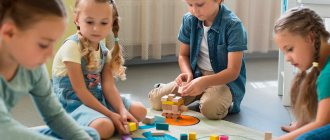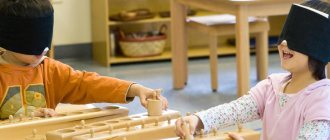MAGAZINE Preschooler.RF
“Sensory development of children of the first junior group “World of Sensorics”“Play permeates a child’s entire life. This is the norm even when the baby is doing something serious. He has a passion and it must be satisfied. Moreover, his entire life should be imbued with this game. His whole life is a game” A.S. Makarenko
Early age is the most favorable time for sensory education of children, without which normal development of mental abilities is impossible. During this period, it is important to improve the activity of the senses, enrich the ideas about the world around us, and develop creative abilities.
Sensory development is the process of forming certain ideas about the external properties of objects of perception in a child: their shape, size, color, size, position in space, smells, taste, and so on. Knowledge begins with the perception of objects and phenomena of the surrounding world.
According to many scientists, sensory development is the main foundation for the general mental development of children and also has independent significance as a way for children to develop sensations, perceptions and ideas. Therefore, from a very early age, children need to accumulate and systematize ideas about the world around them and improve the functioning of the child’s senses.
Let's take a look at what types of sensory sensations should be developed:
- visual sensations - the child sees the contrast between light and darkness, distinguishes colors and shades, the shape and size of objects, their number and location in space;
- auditory sensations - the child hears a variety of sounds - music, sounds of nature, city noises, human speech, and learns to distinguish between them;
- tactile sensations - the child feels through touching, feeling materials of various textures, surfaces of objects of various sizes and shapes, stroking animals, hugging people close to him;
- olfactory sensations - the child inhales and learns to distinguish the various smells of the surrounding world;
- taste sensations - the child tries and learns to distinguish the taste of a variety of food products and dishes.
Different sensory experiences vary in their importance in a person's life. Visual and auditory sensations are dominant.
We work in the first junior group with children 2-3 years old. The child is just beginning to accumulate ideas about color, shape, size and many other properties of objects. It is important that these representations be sufficiently diverse. At this age, we introduce children to primary colors (red, blue, yellow, green); geometric shapes of objects (square, circle, triangle); as well as with various sounds of the surrounding world.
As you know, the main form and content of organizing children’s lives is play. Therefore, we use various didactic games as a means of sensory education for children in our group. They take into account the age and moral motives of the activities of children at play, the principle of voluntariness, the right of independent choice, and self-expression.
Since the main feature of didactic games is educational, we use games during various periods of regime moments. It is very good for children to begin to acquire knowledge about the world around them when they have the opportunity not only to see, but also to actively use it independently. Therefore, it is necessary to use didactic games for sensory development, both in continuous educational activities and in the daily life of children.
We offer you to look at several educational games that our kids love to play in their free time.
A small selection of didactic games on sensory education for children of primary preschool age.
Game "Colors"
Goals: to introduce the child to the primary colors of the rainbow spectrum, to develop memory, attention, speech, and fine motor skills.
Description of the game: The teacher shows the children one of the pictures (for example, a yellow pencil). Children are asked to find and attach a picture that depicts objects of the same color (for example, a yellow sun, etc.).
Game "Hedgehogs"
Goal: to learn to differentiate various geometric shapes, relying on tactile and visual sensations, that is, to develop tactile and visual perception.
Description of the game: Children must independently find the colors and details of the hedgehogs, connecting them into one whole.
Lacing game
Goal: to develop fine motor skills of the hands, refinement of finger movements, concentration, promote the development of eye accuracy, coordination and sequence of actions.
Description of the game: the teacher invites the children to “sew on” the missing pieces of clothing.
Game: “Wonderful bag”
Goal: finding familiar objects by touch.
Game description: There are objects in an opaque bag. The child is asked to find the desired item by touch, without looking into the bag.
Game "Magic clothespins"
Goals: to promote the development of the movement of clenching and unclenching the fingertips of the right and left hands.
Game description: attach clothespins according to theme (rays to the sun, needles to a hedgehog, petals to a flower, ears to a bunny’s head...)
Game "Colorful Sticks"
Goal: to teach children to distinguish primary colors, to practice arranging sticks in boxes of the corresponding color, to develop visual perception and fine motor skills.
Description of the game: The teacher places boxes of four colors on the table and shows the multi-colored sticks that the bear scattered.
Children participants are asked to put all the sticks into boxes of their own color.
Game "Find a Pair"
Goal: to teach how to select animals based on patterns.
Description of the game: the teacher invites the children to find identical animals and tell who they are.
| Next > |
Pedagogical project “We play games, develop sensory skills”
He pinches his fingers in his sleep.”
Change of hands
“Give me some food quickly.
Me and my whole family!”
Game “Drawing on the Croup”
— Take a spread with a bright pattern. Sprinkle any small grains over it in a thin, even layer. Run your finger over the grain. You will get a bright contrasting line. Try to draw some objects (fence, rain, waves, letters). This kind of drawing not only promotes the development of fine motor skills, but also massages your baby’s fingers. And plus the development of fantasy and imagination.
Games with clothespins.
The clothespin itself is a ready-made, self-sufficient toy. You just have to play with the opening and closing of a clothespin (a dog barks, a duck quacks, etc.) And in combination with cardboard silhouettes-blanks, you can systematically work with children on the development of all aspects of speech, at the same time developing memory, attention, imagination, fine motor skills. .
Today we got acquainted with only a small part of what you can do in your leisure time with your child at home. Use your imagination and most importantly, don’t get tired of constantly talking to your kids, name all your actions, natural phenomena, colors and shapes. Let the child be in a constant flow of information, rest assured, it will not tire him. The more relaxed the training, the easier and faster it will be. Encourage your child to play as much as possible, play educational and fun games with your baby. Take part in the gameplay. This will be a great way to establish a stronger bond between you and your child!
4. Reflection game “Sun”
— Dear parents, we offer to evaluate our master class, for this you need to dip your palm in the appropriate paint and leave an imprint in the sun like a ray. Red color – I liked everything, you will use the games at home; yellow color - you liked it, but not everything, you will take note of something; orange color - we haven’t learned anything new.
The resulting sun will decorate our group, warm and delight our children.
Appendix No. 3
Parent meeting on the topic “Journey to the Land of Sensorics.”
Target:
enriching parental ideas about the sensory development of children of primary preschool age, sharing experiences of family education, participation in group life. The development of sensory perception is necessary for the mental development of the child. Knowledge of sensory standards will help your child in learning at school.
Sensory development is the development of perceptions, ideas about objects, phenomena and objects of the surrounding world.
There are five sensory systems with the help of which a person experiences the world: vision, hearing, touch, smell, taste. You encounter sensory standards everywhere and can introduce them to children without a specially prepared environment. When dressing and undressing, pay attention to the color of your clothes and your child’s clothes. When looking at clothes, name its color, and learn to find the same color in other clothing options and in other items. At the same time, you will expand your child's vocabulary.






